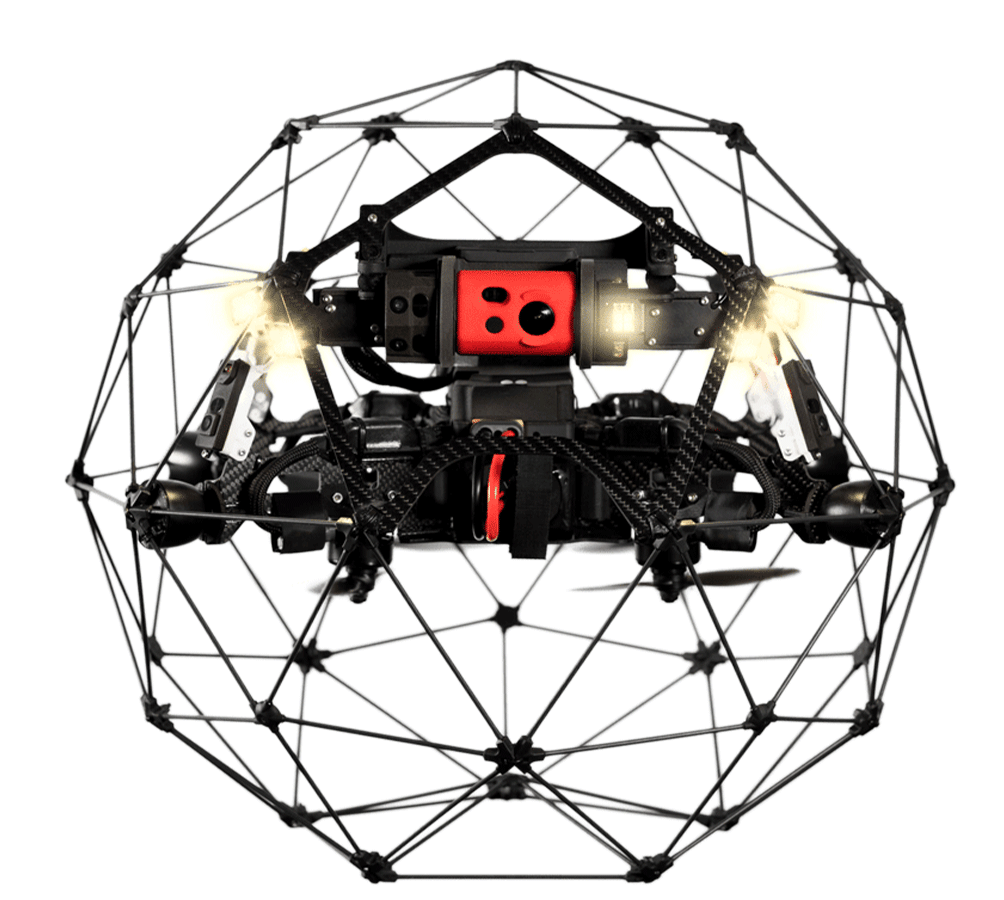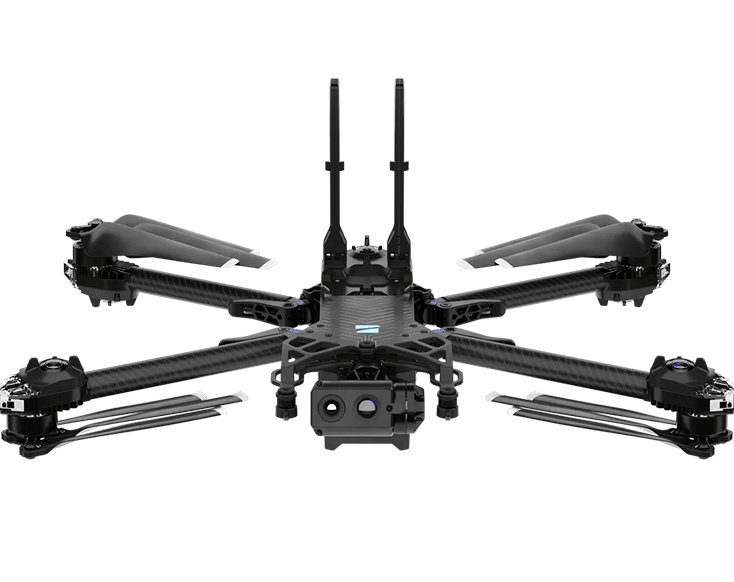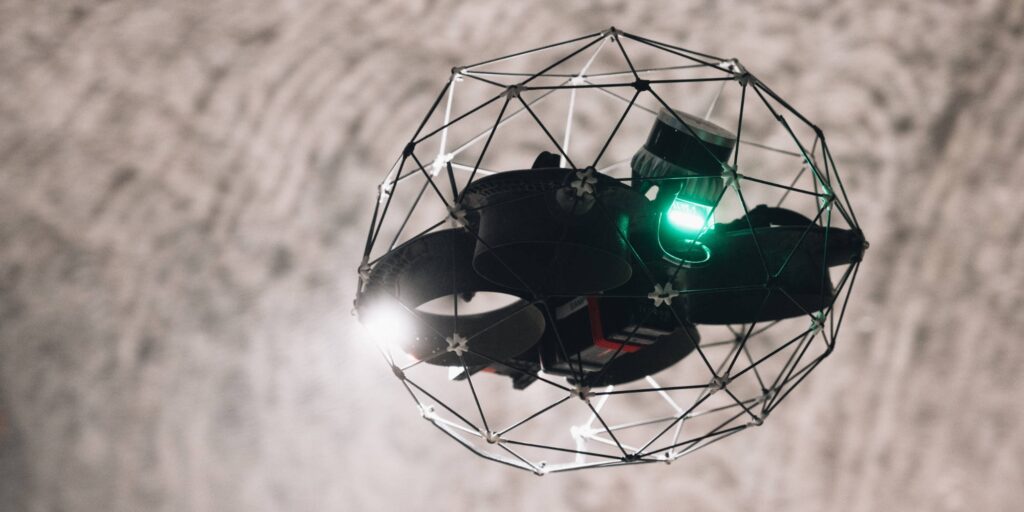
Ressources / Guide / Indoor Drones: Top Models of 2025 & More
Guide
Indoor Drones: Top Models for 2025 & More
Looking for the top indoor drones of 2025? You came to the right place.
An indoor drone is any drone made for use indoors.
Indoor drones have a variety of uses and price points—indoor toy drones are made mainly for kids, indoor FPV drones are made for racing, and professional indoor drones are made for inspections and other types of indoor work.
In this guide we’ll cover why you might want to fly a drone indoors, the different types of indoor drones on the market, and examples and use cases for professional indoor drone applications.
[Lire aussi : The DJI Ban Explained—What You Need to Know]
Here are the best professional indoor drones on the market right now:
The Best Professional Indoor Drones [New for 2025]
Here are the top professional indoor drones out there right now.
1. Flyability’s Elios 3
The Flyability Elios 3 is an advanced indoor inspection drone built for navigating the toughest, most confined industrial spaces.
With its robust collision-tolerant cage, powerful 3D LiDAR mapping, and centimeter-level indoor localization, the Elios 3 lets inspectors see and map areas that were previously unreachable or unsafe.
- Conception tolérante aux collisions. Safely navigates and recovers from impacts in tight, GPS-denied spaces
- Ouster OS0-32 LiDAR. Enables high-precision, real-time 3D mapping indoors
- SLAM-based navigation. Centimeter-accurate positioning without GPS signals
- Baie modulaire pour la charge utile. Supports flexible, mission-specific sensor integration
- Operator safety. Remote visual inspection minimizes the need for human entry into hazardous areas
- Oblique lighting system. Reduces dust interference for clearer images and video
2. Flyability’s Elios 2
The Flyability Elios 2 is a pioneering inspection drone engineered for navigating and documenting confined, GPS-denied industrial spaces.
Its carbon fiber cage ensures collision tolerance, while the integrated 4K camera and LED lighting deliver clear visuals even in dusty, dark environments.
- Collision-tolerant cage. Safely operates in tight and cluttered environments
- 4K camera and LED lighting. Captures crisp images and video in low-light or dusty spaces
- Intuitive flight controls. Precision navigation for operators of all experience levels
- 180° tiltable payload. Optimized for inspecting overhead and hard-to-reach angles
- Real-time data streaming. Immediate access to inspection results
- Operator safety. Minimizes the need for direct human entry into hazardous areas
3. Skydio’s X10
The Skydio X10 is a next-generation autonomous inspection drone, purpose-built for professionals who demand the highest precision, safety, and situational awareness in dynamic and complex environments.
Backed by a powerful onboard AI and modular sensor packages—including the latest Teledyne FLIR Boson+—it delivers unmatched imaging, true 360° obstacle avoidance, and persistent reliability, even in GPS-denied or harsh outdoor conditions.
- Powerful AI & Autonomy. NVIDIA Jetson Orin processor enables autonomous navigation and data capture in GPS- and communications-denied settings
- High-resolution multi-sensor payloads. 50 MP wide, 48 MP telephoto, 64 MP narrow, plus 640 × 512 px thermal imaging
- True 360° obstacle avoidance. Six navigation lenses eliminate blind spots for safe, confident flight indoors and out
- Rugged, weather-resistant design. IP55 rated for dust and water protection; deployable in under 40 seconds
- Outstanding battery performance. Up to 40-minute flight time per battery
- Modular, upgradeable architecture. Future-proof platform with swappable sensor and communication modules
- Night and low-light operation. NightSense and powerful onboard lights for autonomous flight in darkness
- Enterprise-ready security. NDAA compliant, encrypted data links, and secure storage
The Skydio X2 is a rugged enterprise drone designed for industrial inspections, public safety, and intelligence missions in both indoor and outdoor environments.
Powered by Skydio’s advanced AI-driven autonomy, it offers exceptional obstacle avoidance, dual-sensor imaging (color and thermal), and robust all-weather operation. Its foldable airframe, rapid deployment, and NDAA compliance make it an ideal solution for professionals who need reliable, actionable aerial data in challenging conditions.
- Dual-sensor payload. 12 MP color camera and FLIR thermal for high-resolution imagery day or night
- Évitement des obstacles à 360. Multiple navigation cameras for safe, autonomous operation even in complex environments
- Foldable, portable design. Easy transport and fast deployment in the field
- Temps de vol prolongé. Up to 35 minutes per battery for uninterrupted missions
- Rugged, all-weather construction. Engineered for performance in demanding industrial or tactical scenarios
- NDAA compliant. Meets U.S. federal security standards for sensitive operations
- Enterprise connectivity. Encrypted communication and secure data storage
Can You Fly a Drone Indoors?
Before we go any further, you might be wondering whether you can fly a drone inside at all.
The answer is yes, absolutely you can—if your drone was made to fly indoors.
But how can you tell if you have an indoor drone?
Start by looking at the language your drone’s manufacturer uses to describe your drone. If the words ‘indoor’ or ‘inside’ are used, you’re probably good to go.
Alternately, just look at the drone and think about how much space it will need to fly and whether it might get damaged or hurt something (or someone) if it were to crash inside your home.
When you’re looking at a microdrone that weighs half a pound and has protected propellers, like the one in the image below, it’s pretty clear that it won’t do any damage if it were to crash in your house.
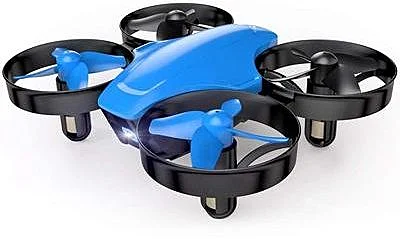
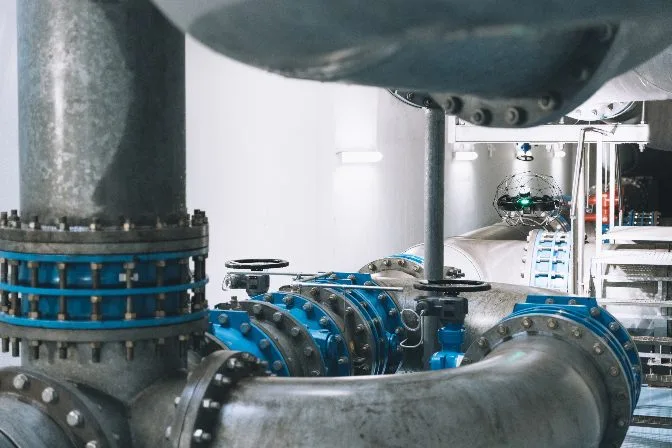
Why Fly a Drone Indoors?
There are a lot of different scenarios that might call for indoor flying. And there are different types of interior drones to go along with each of these scenarios.
Here are some of the most common reasons for wanting to fly a drone inside, along with the type of drone best suited for each reason.
For fun. Toy indoor drones, also called microdrones, are best for this type of flying.
For practice. Toy indoor drones are also usually your best option for this type of flying too, although you could try flying with a regular commercial drone using an add-on cage if you only want to practice flying a certain model of drone.
For racing. Racing indoor drones are best for this type of flying.
For work. Professional indoor drones are going to be your best—and only—option if you want to fly indoors for any kind of work-related need, such as inspections, visual data collection, or 3D modeling.
But is it legal to fly a drone indoors?
Asking yourself, Can you fly a drone in your house? Or somewhere else indoors?
The answer to this is yes, in most countries it’s not only legal to fly a drone indoors, it’s also the least regulated place you can do it.
In the U.S., for example, the FAA’s rules concerning drone operations do not apply to indoor flights. This means that you can fly indoors, either for work or for fun, without having to meet the same regulatory requirements you’d have to meet if you were flying outside.
The Three Types of Indoor Drones
Now that we’ve covered the reasons you might want to fly a drone indoors, let’s take a closer look at the different types of inside drones on the market.
Here’s a list of the three types in case you would like to jump around:
1. Toy Indoor Drones
A toy indoor drone is any kind of drone made for hobbyists that can be safely flown indoors, like the microdrone we covered above that weighs only 8 ounces.
Here are some key characteristics of toy indoor drones:
- They’re lightweight. Toy indoor drones usually weigh less than a pound.
- They have short battery lives. Toy indoor drones usually only have flight times of 5-15 minutes.
- They typically don’t have cameras. Toy indoor drones often won’t have a camera. If they do have one, it’s usually not high quality.
- They’re inexpensive. Toy indoor drones usually cost less than $100 U.S.
- They’re safe. Almost all toy indoor drones come with propellor guards (also called prop guards), and are so lightweight that they won’t hurt you or your things if they crash.
2. FPV Racing Indoor Drones
Racing indoor drones are another special category of indoor drone.
Indoor racing drones are not just another type of toy drone. As drone racing has evolved, the technology behind racing drones has improved to an impressive extent.
When it comes to racing drones, the indoor scenarios these drones are made to fly in are big, open spaces with indoor drone race tracks. These drones are not made for flying in your living room.
Here are some key characteristics of racing indoor drones:
- They’re FPV (First Person View). Indoor racing drones are all going to be FPV, with a screen and/or goggles that allow you to see what the drone sees as it flies in real time.
- They’re fast. These drones are made for racing, so they go fast—very fast.
- They’re *probably* not for flying at home. Given how fast these drones can go, you probably don’t want to fly them at home.
- Safety is available—but not guaranteed. Unlike with toy indoor drones, indoor racing drones may not always come with prop guards. However, these will usually be available as an additional purchase.
3. Professional Indoor Drones
Toy drones and racing drones are made for specific types of flying: either you want to fly for fun, or you want to race.
But professional indoor drones can be used in a variety of different scenarios, including:
- Collecting visual data for inspection purposes inside industrial assets like boilers, pressure vessels, or chimneys.
- Replacing the need for a human to enter a confined, hazardous space. For example, in nuclear power plants, indoor drones can replace the need for humans to expose themselves to radiation in order to collect visual data.
- Entering spaces that are difficult for humans to access, like sewers, mines, or even parts of amusement park rides.
Some of the biggest industries using professional indoor drones these days are Oil & Gas, Mining, and Power Generation.
But there are lots of others. Check out our case studies to learn more about the different industries that perform indoor drone inspection.
Here are some key characteristics of indoor inspection drones:
- They often have cages. Drone cages serve the dual purpose of protecting the drone from damage and protecting those using the drone from injury.
- They have high-end cameras. Most professional indoor drones are used to collect visual data in confined spaces. This means they need to come with high-quality inspection cameras in order to collect high-quality visual data.
- They have different sensor options. Many professional indoor drones come with a thermal camera option, or the option to switch out payloads for a thermal camera or other sensor. As indoor drone technology continues to be developed it’s likely that other types of NDT (Non-Destructive Testing) sensors may become available as payload options.
Two Categories of Drone Cages
Although all professional indoor drones have drone cages, not all drone cages are the same.
Currently, there are two different categories of drone cages on the market:
1. Indoor Drones with Add-On Cages
These are consumer drones that weren’t made for indoor applications, but instead have a separate cage that’s been purchased and added onto the drone. Drones with add-on cages aren’t ideal for most industrial settings because they weren’t created to sustain collisions.
2. Indoor Drones with Built-In Cages
Indoor drones with built-in cages were designed to sustain collisions in order to support heavy-duty industrial work that requires flying in confined spaces.
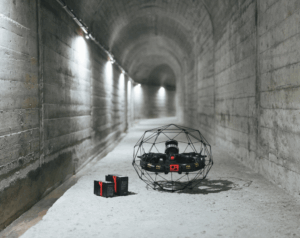
While an add-on cage is designed and created separately from the design and creation of the drone to which it is attached, fixed cages for indoor drones like the Elios 1, Elios 2, and Elios 3 are designed from the ground up to allow the drone to sustain collisions and continue flying.
This makes a huge difference when it comes to the longevity of the drone, since it can collide without any damage.
It also makes a big difference for the quality of visual data the drone can collect, since collisions do not have as much of an impact on the drone’s trajectory as they will with an add-on cage, or on the resulting video footage the drone collects.
Indoor Drone FAQ
Here are answers to the most commonly asked questions about indoor drones.
What is an indoor drone?
An indoor drone is any drone specifically designed to be flown indoors. These drones are often smaller, lighter, and equipped with safety features like propeller guards or protective cages to reduce the risk of injury or property damage during indoor flights.
Can you fly a drone inside your house?
Yes, you can fly a drone inside your house, as long as it is safe to do so. Toy drones and microdrones are typically best for indoor use due to their small size, lightweight build, and built-in prop guards. Larger drones like camera drones or FPV racing drones are usually not well-suited for tight indoor spaces.
Is it legal to fly a drone indoors?
In most countries, including the United States, flying a drone indoors is completely legal. FAA regulations and similar laws typically only apply to outdoor drone operations in navigable airspace. However, you should always fly safely and be aware of your surroundings when flying indoors.
What are the best drones for indoor flying?
The best indoor drones depend on your use case:
- For fun or learning: Mini drones like the Holy Stone HS210 or Ryze Tello
- For FPV racing: Lightweight FPV drones like the BetaFPV Meteor75
- For industrial inspections: Confined-space drones like the Flyability Elios 3
What features should an indoor drone have?
Key features to look for in an indoor drone include:
- Lightweight design
- Propeller guards or a protective cage
- Stability sensors or altitude hold
- Low-noise operation
- Optional: onboard camera or FPV capability
Can professional drones be flown indoors?
Yes. Professional drones like the Elios 3 are purpose-built for flying in confined indoor environments such as boilers, tanks, silos, and sewer systems. These drones are designed to operate in GPS-denied spaces and often feature collision-tolerant cages, advanced stabilization, and inspection-grade cameras.
Do indoor drones need GPS?
No, most indoor drones are designed to operate without GPS. Instead, they rely on vision-based stabilization, barometers, infrared sensors, or ultrasonic sensors to maintain position and altitude indoors, where GPS signals are weak or unavailable.
What’s the difference between indoor drones and outdoor drones?
Indoor drones are typically smaller, lighter, and optimized for close-quarters flight, often with features like propeller guards or protective cages. Outdoor drones are larger, often GPS-enabled, and built to handle wind and weather conditions. Some drones are versatile enough to handle both environments, especially with added safety features.
Are there drones made specifically for confined spaces?
Yes. Drones like the Flyability Elios series are specifically engineered for confined space inspections. These drones are designed to operate in tight, GPS-denied environments and come with rugged protective cages to handle collisions during flight.


